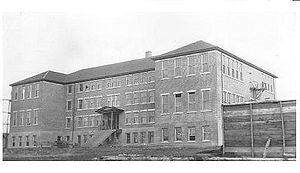
Lejac Residential School
Encyclopedia

Canadian residential school system
-History:Founded in the 19th century, the Canadian Indian residential school system was intended to assimilate the children of the Aboriginal peoples in Canada into European-Canadian society...
and one of the 130 boarding schools for First Nations
First Nations
First Nations is a term that collectively refers to various Aboriginal peoples in Canada who are neither Inuit nor Métis. There are currently over 630 recognised First Nations governments or bands spread across Canada, roughly half of which are in the provinces of Ontario and British Columbia. The...
children that operated in Canada between 1874 and 1996. Operated by the Roman Catholic Church
Roman Catholic Church
The Catholic Church, also known as the Roman Catholic Church, is the world's largest Christian church, with over a billion members. Led by the Pope, it defines its mission as spreading the gospel of Jesus Christ, administering the sacraments and exercising charity...
under contract with the government of Canada, construction was completed on January 17th 1922, succeeding the school opened in 1917 in Fort Saint James. It was located in an otherwise undeveloped area on the shore of Fraser Lake about half-way between the town of Fraser Lake and the village of Fort Fraser, just off the railway line. The location was about 10km from the Indian village of Stelako at the West end of the lake and the village of Nadleh at the East end of the lake. Although there were a few lay employees, most of the staff were religious, the men Oblates of Mary Immaculate, the women Sisters of the Child Jesus. The school was named after Father Jean-Marie Lejacq, an Oblate missionary who co-founded the mission at Fort Saint James in 1873.
Due to its location at the centre of Carrier
Dakelh
The Dakelh or Carrier are the indigenous people of a large portion of the Central Interior of British Columbia, Canada.Most Carrier call themselves Dakelh, meaning "people who go around by boat"...
country, the majority of students were Carrier, but Lejac also enrolled substantial numbers of students from neighbouring tribes, including the Sekani
Sekani
Sekani is the name of an Athabaskan First Nations people in the Northern Interior of British Columbia. Their territory includes the Finlay and Parsnip River drainages of the Rocky Mountain Trench. The neighbors of the Sekani are the Babine to the west, Dakelh to the south, Dunneza to the east, and...
and Gitksan.
As with most other residential schools, former students have charged that they were physically and sexually abused.
After the school closed in 1976 the land was transferred to the Nadleh Indian Band and the school buildings razed. What remains at the site are the cemetery and a memorial, the site of an annual pilgrimage in honor of Rose Prince
Rose Prince
Rose Prince was a Dakelh woman who has become the subject of a Catholic pilgrimage.-Biography:Rose Prince was born in Fort St. James, British Columbia, in 1915, the third of nine children belonging to Jean-Marie and Agathe Prince...
, a Carrier girl who remained to live and work at the school whom some consider a candidate for sainthood.

